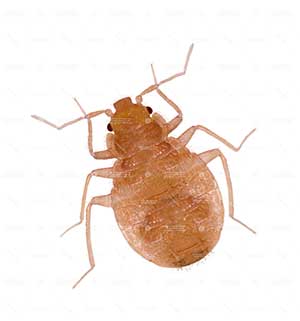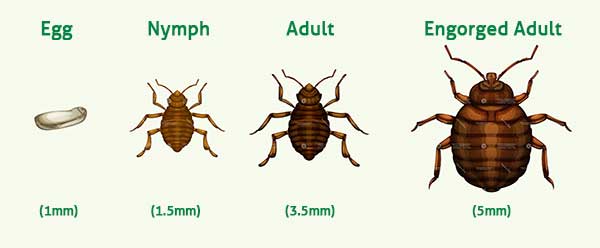If you live in an area where there have been reports of bed bugs or suspect you may have them, you need to get an inspection right away. It’s important to note that bed bug size is dependent on the stages of development. You may not always be able to see them, but you could have them. If you live in an apartment building they can spread between units extremely fast. Bed bugs can also travel on a person; this is so they can jump or move outside of the place they currently reside.
Bed Bugs
Bed bugs are notorious for hiding in the most inconspicuous locations in homes and items around a room. So, can you see bed bugs if you are looking for them? The answer is it depends. This is because there are 8 stages to a bed bug’s life cycle and by the time you realize you have a bed bug bite you are most likely in the late stages of development. Let’s take a look at the stages and what makes them so hard to find when you’re looking for them in your home.
If you have adult bed bugs, they are quite visible. Generally about the size of an apple seed, and they live off of blood. Not just human blood, though. They may also attack your pets. Bed bugs have been with humans for more than 3,300 years and are found everywhere people gather, not just in your home. They are commonly found in hotels, schools, offices, retail stores, and on public transportation. They can quickly get into your purse, briefcase, suitcase, jacket and therefore can travel long distances. They can be confused with similar-looking bugs, so often, people are not always aware they have them. It can also be challenging to recognize their bite marks. This allows them to infest the area quickly as you may be unaware that you have them.
Bed Bug Size Can Vary
If you suspect you may have bed bugs or are trying to be vigilant about keeping them away, you must know what to look for. While they may vary, bed bugs are usually oval and are not very big. Maybe only 3/16th of an inch long. Before they feed, they are brown and flat, but after, bed bugs become redder and more prominent. Bed bug nymphs can be harder to see, as they are smaller and paler.
Bed bugs have six (6) legs and two (2) antennae. The adult bugs will be identified relatively quickly, as can their fecal droppings. You will see either on your mattress or mattress seams and on the box springs, other upholstery, or even the floor or walls.
If these spots are found, take it as a good indication you have an infestation. Bites on the arms and legs are also a good sign you have them, notably a series of bites all in the same place. These small little bites can be itchy and swollen and may cause other irritations. They can be from other insects, like mosquitoes or ants, so make sure you check for bed bugs to be sure. They also shed their skin, their eggs, empty eggshells, besides the bugs themselves. While these items are relatively small, you should still be able to see them. Bed bugs and their eggshells appear pale white after molting or emerging from the eggshell.
Stages of Bed Bugs
Even if you sprayed or took all the precautions needed to get rid of or prevent bed bugs, if you miss just one bed bug that has eggs you can be in for a massive outbreak. The female can lay anywhere from one to five eggs every day. Out of the seven (7) stages of the bed bug’s journey to maturity, it only takes about five (5) weeks for a hatched nymph to reach adulthood.
Egg
Bed bug eggs are only 1mm big. To give you some perspective this is 33% smaller than the head of a pin. These eggs are so small that they are almost completely invisible to the naked eye. Even if you see these eggs you most likely won’t be able to recognize what they are. They are off white or pearl white in color. This color makes it even more difficult to see them.
Nymph
When asking “can you see bed bugs?” the nymph stages are when you can technically start to see them. Between the 1st and 5th stage the development takes up to 4 weeks and these nymphs are small and translucent and then start to get a darker color as they move through the stages. They are most visible after they have fed but they get harder to see as they get away from that blood meal. Once the bed bug gets to the 5th stage of development the size is about the size of a small drill hole.
1st stage nymphs are 1.5 millimeters in length. As soon as they come out of their eggs, they can start feeding immediately. This will depend on the temperature and the food supply. As they feed and grow, they molt. This continues through the second to the sixth stages of their life. They grow and molt through five stages. They will grow up to about 4.5 mm, or the size of an apple seed, when mature.
- 1st stage nymph (1.5 mm)
- 2nd stage nymph (2 mm)
- 3rd stage nymph (2.5 mm)
- 4th stage nymph (3 mm)
- 5th stage nymph (4.5 mm)
Adult
Adult bed bugs are going to be between 5-7mm or ¼ inch long. They are visible to the naked eye and will see them crawling. They have a balloon like reddish-brown and they even produce a musty odor through the glands. Often when you’re finding source hiding spots you will see lots them and staining on mattress and sheets. It takes 6-7 weeks for bed bugs to reach this visible state. Unfortunately, by this time there have been other bed bugs that have begun laying eggs and the cycle begins again. You can have multiple eggs starting development and most likely when you see an adult bed bug you are deep in the process. A bed bug’s lifespan is generally about four to six months, but under the right conditions can live up to a year.
The visibility of bed bugs makes the process of elimination and the process of identifying them very difficult. By the time you realize you are having an issue you have most likely already been in the process for weeks if not months. Therefore, they are so difficult to prevent or stop early in the process. This is also why companies will find the elimination of these pests one of the most difficult. We recommend going with a large local company to ensure you have someone with the knowledge, resources and experience dealing with these difficult pests.
Prevention and Removal | Bed Bug Size
If you found out one of your neighbors, someone you know or someone you have come in contact with has bed bugs, you should take preventive measures right away. Because the stages of bed bug size can vary you should not assume you don’t have an infestation if you can’t see them.
Get Rid or Clean Contamination Items
- Remove a lot of the clutter around your home, particularly around your bed. If you have boxes, bags, or other items stored under your bed, remove them. This must include stuffed toys, blankets, additional bedding, smaller electronics, and anything usually there.
- Bag the items where they are to prevent moving the bugs to another room or area. Take the items for laundry or disposal right away.
- Launder sheets and other items on hot water. If you want to spray them first, do it while they are in the bag. Dry them on hot for at least 30 minutes, and make sure you discard the plastic bags.
- Check out all your sockets, as they can get in there and live. It’s warm in there, which is what they like.
- Take your bed frame apart and spray and clean all the little places they can hide and hang out.
- Treat your mattress and then cover the mattress and box spring with encasements. Once the encasements are on, the bugs can’t get in or out. If you can still see them inside, you can leave them, as they will have nothing to feed on and perish.
Call EnviroPest Bed Bug Exterminators
It is your landlord’s responsibility to let you know if someone in the building has bed bugs in most places. They should also take at least partial responsibility for the treatment. While do-it-yourself methods can work, you are better off calling a pest control expert to help you. They know where to look and what to do to get rid of them.



